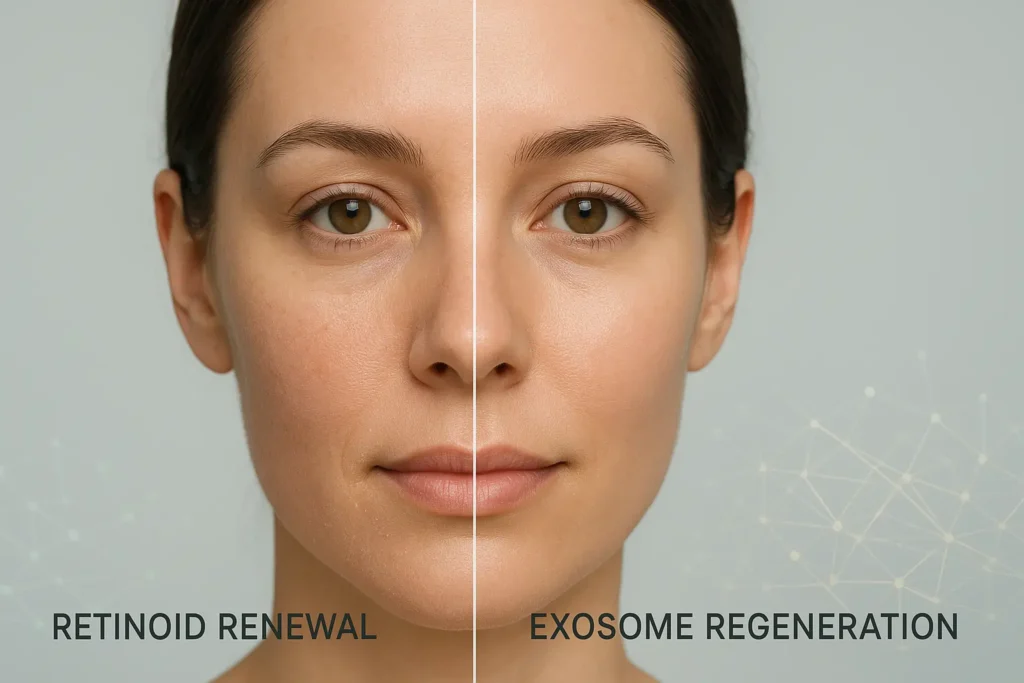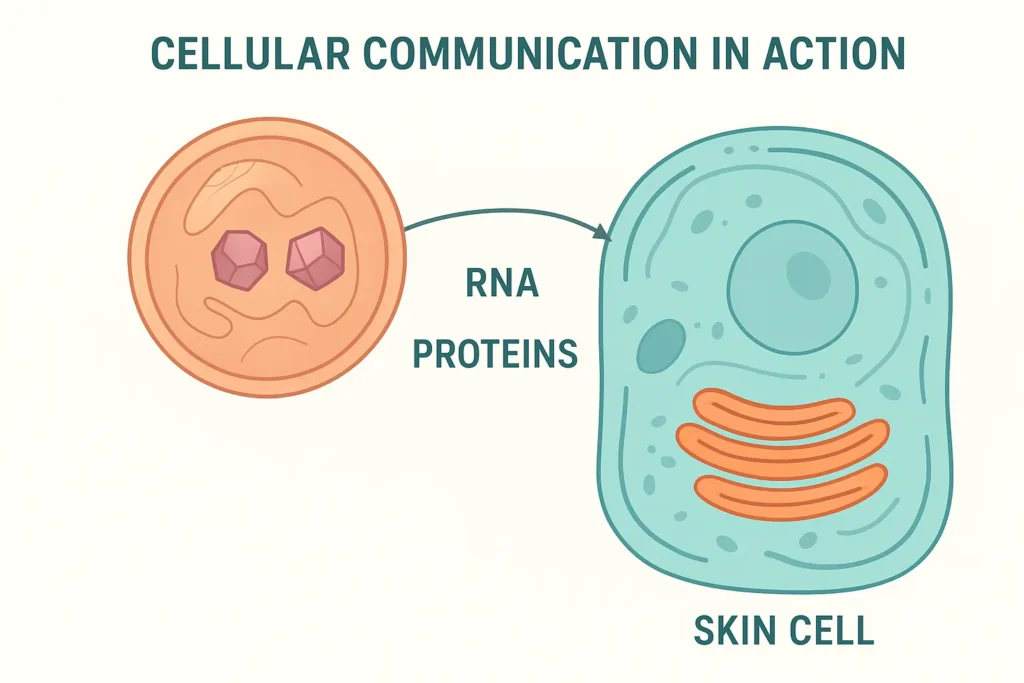Exosomes vs Traditional Retinoids: Cellular-Level Skincare Revolution in 2025
“Are exosomes the next generation of retinoids?”
In 2025, dermatologists and cosmetic scientists are calling it a cellular revolution! Is the hype real? Or are exosomes just the latest trend? Scientific American, in a 2024 study, notes that “retinol…significantly benefits skin, especially in treating acne and signs of aging” – a reputation earned by decades of research.
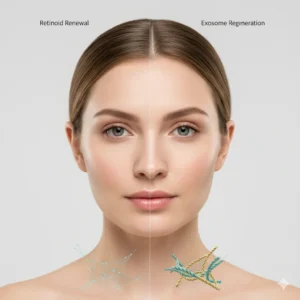 Exosomes — those tiny, powerful biological messengers once used in regenerative medicine — are now finding their way into serums, creams, and clinic treatments. But how do they really stack up against retinoids, the old gold standard of anti-aging?
Exosomes — those tiny, powerful biological messengers once used in regenerative medicine — are now finding their way into serums, creams, and clinic treatments. But how do they really stack up against retinoids, the old gold standard of anti-aging?
I’ve worked with retinoids in clinical practice for years. From prescription-strength tretinoin to over-the-counter favorites like The Ordinary’s retinol or SkinCeuticals Retinol 0.5, I’ve seen their impact firsthand. They smooth fine lines, even tone, and renew the skin’s texture. But they also come with a cost: irritation, peeling, and sensitivity.
Meanwhile, exosomes promise something different — targeted skin communication and repair without the sting.
In this article, we’ll break down both at the cellular level, exploring how exosomes and retinoids repair, renew, and rejuvenate the skin. You’ll learn which option suits different skin types, age groups, and climates, and get expert guidance backed by dermatological research and global clinical studies.
Research published in Pharmaceutics shows:
“Exosomes were found to contain intricate compositions, including proteins, lipids, nucleic acids, and bioactive molecules, crucial for maintaining skin homeostasis. Emerging evidence highlights their involvement in dermatological conditions and their potential as diagnostic biomarkers and therapeutic agents,”.
So, let’s break this down at the cellular level — understanding how exosomes and retinoids each renew skin, and which is better for your unique skin type, climate, and goals.
What Are Exosomes and How Do They Work?
Exosomes are tiny extracellular vesicles — microscopic messengers your cells release to communicate with one another. Think of them as the text messages of the cellular world. Each exosome carries vital information in the form of proteins, lipids, and RNA that help repair, regenerate, and balance your skin’s ecosystem.
Initially studied for their role in regenerative medicine and wound healing, these vesicles are now a significant player in the skincare industry.
How Exosomes Communicate With Skin Cells (Cell-to-Cell Signaling)
When applied to the skin through serums or in-office treatments, exosomes act like messengers whispering to your cells: “Hey, it’s time to heal.” They deliver molecular cues that instruct fibroblasts to produce more collagen, keratinocytes to renew more rapidly, and immune cells to mitigate inflammation. In other words, exosomes don’t force change — they invite it through gentle biological signaling.
Exosome Benefits for Aging, Inflammation, and Healing
Exosomes have been shown to increase collagen and elastin synthesis while reducing oxidative stress. They’re particularly beneficial for mature or sensitized skin that can’t tolerate potent actives.
In the UAE and Saudi Arabia, dermatologists use exosome facials after laser or microneedling treatments to accelerate recovery and minimize redness. In India and Pakistan, clinicians are exploring exosome-infused serums to fade pigmentation and post-acne marks.
Clinical Studies Validating Exosome Skincare Efficacy
According to clinical reviews (PubMed, 2023–2025), exosomes derived from mesenchymal stem cells enhance collagen production by up to 30% within eight weeks and improve wound closure by 50% faster than standard moisturizers. Unlike retinoids, exosomes do not cause flaking or purging — making them ideal for sensitive and rosacea-prone skin.
What Are Traditional Retinoids?
Recent clinical research has established exosomes derived from mesenchymal stem cells as effective agents for skin regeneration and repair.
Clinical studies have demonstrated measurable efficacy in addressing skin aging, scarring, hair restoration, and melasma, with exosomes showing additional potential as therapeutic agents for inflammatory skin conditions like atopic dermatitis.
These extracellular vesicles function by promoting cell proliferation, enhancing angiogenesis, and stimulating collagen synthesis through various cellular pathways, including the PI3K/Akt and TGF-β/Smad signaling pathways.
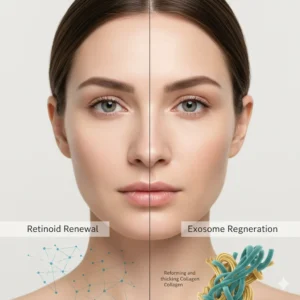 In controlled trials, topical exosome treatments have yielded statistically significant outcomes, including reduced wrinkles, decreased redness and melanin, improved skin luminosity, and more even skin tone.
In controlled trials, topical exosome treatments have yielded statistically significant outcomes, including reduced wrinkles, decreased redness and melanin, improved skin luminosity, and more even skin tone.
Unlike traditional retinoid treatments that often cause irritation, flaking, and purging, exosome-based therapies are well-tolerated with minimal side effects, making them particularly suitable for individuals with sensitive or rosacea-prone skin. The growing body of evidence is reflected in 388 ongoing clinical trials worldwide, with the first approved exosome therapeutic products anticipated by 2029.
Mechanism of Action: Speeding Cell Turnover and Collagen Synthesis
Retinoids bind to nuclear receptors in skin cells, signaling them to produce more collagen, elastin, and hyaluronic acid while shedding dull, dead cells on the surface. This controlled “cellular chaos” accelerates renewal, revealing smoother and firmer skin underneath.
Studies from the American Academy of Dermatology confirm that retinoids increase collagen density, decrease fine lines, and normalize pigmentation with consistent use.
Retinoid Tolerance, Irritation, and Purging Phase
Here’s the catch: all that cellular acceleration can overwhelm your skin at first. Redness, peeling, and sensitivity — the dreaded “retinol purge” — are common when you start. For humid regions like India or Pakistan, where higher sebum levels can buffer irritation, this phase may be shorter.
In drier climates like the U.K. or the Gulf, moisture loss amplifies irritation, which is why pairing retinol with emollients (like Neutrogena’s Rapid Wrinkle Repair Cream or The Ordinary’s Squalane-based retinol) makes a huge difference.
Key Research and Dermatologist Consensus
According to dermatologists worldwide, retinoids remain the gold standard for reversing visible aging. They’ve been proven through decades of controlled studies to increase collagen production, smooth texture, and reduce pigmentation irregularities by stimulating collagen synthesis while inhibiting matrix metalloproteinase (MMP) activity [PubMed].
Clinical research demonstrates that topical retinol restores Type I collagen production in photoaged skin within four weeks of application. For hyperpigmentation treatment, retinoids improve melanin distribution in the skin, reducing discoloration and pigmentation by up to 60% [Review Article in Frontiers].
These benefits extend beyond wrinkle reduction to include stimulating the formation of new blood vessels, which improves overall skin color and texture.
The extensive body of evidence supporting retinoids for anti-aging and skin texture improvement continues to reinforce their position as the most reliable, scientifically validated option in evidence-based skincare.
Exosomes vs Traditional Retinoids — A Cellular Comparison of How Both Impact Collagen and Elastin Regeneration
Retinoids stimulate fibroblasts to produce collagen via retinoic acid receptor activation — an assertive but aggressive process.
Exosomes, on the other hand, deliver growth factors that encourage fibroblasts to regenerate collagen and elastin naturally. While retinoids push skin cells into overdrive, exosomes guide them to heal intelligently.
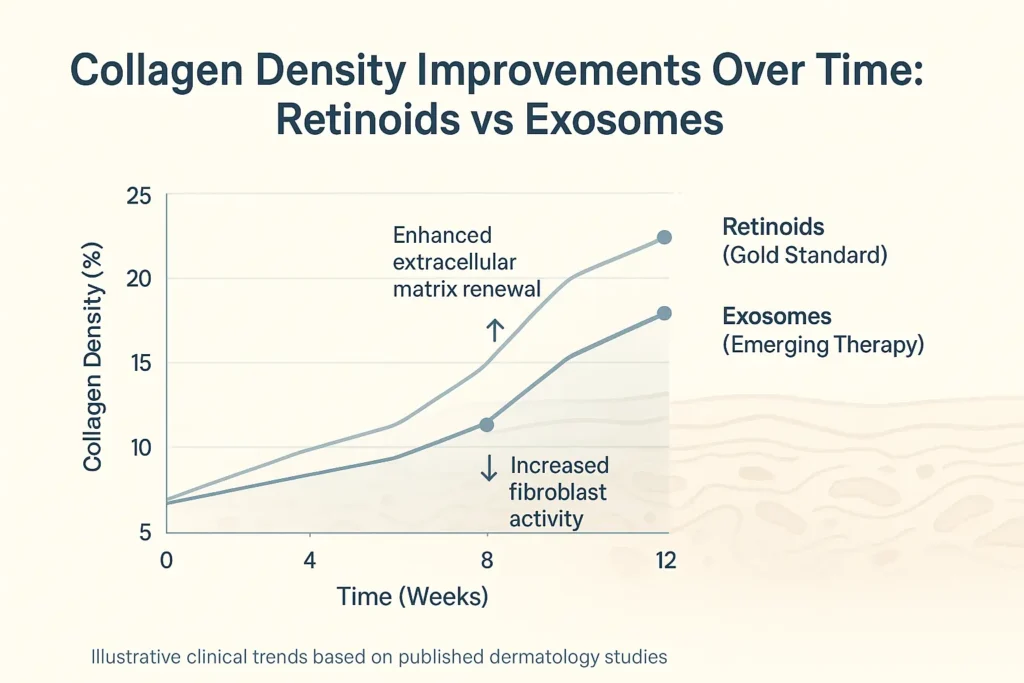
Differences in Cell Signaling Pathways
Retinoids act directly on the cell nucleus, altering gene expression. Exosomes act externally, sending biochemical cues to initiate repair. This means exosomes work in harmony with your natural skin rhythm — fewer flare-ups, faster barrier recovery, and improved hydration levels.
Comparative Studies
A clinical study conducted by the Korean Skin Research Centre found that a serum containing exosomes, peptides, and spicules outperformed retinol by 7.2 times in wrinkle reduction and 17 times in pigmentation reduction after 8 weeks. It also demonstrated a 65% increase in collagen production and a 33% reduction in wrinkles within the first 2 weeks.
A 2024 research in the Journal of Clinical, Cosmetic and Investigational Dermatology found that collagen density increased from 12.44% pre-treatment to 13.15% post-treatment with topical exosome treatment, representing a 5.77% increase.
Synergistic Potential: Can You Use Both?
Absolutely. Using exosomes in the morning (for repair and enhancing barrier strength) and retinoids at night (for renewal and stimulating collagen production) offers the best of both worlds.
Dermatologists from London to Riyadh are experimenting with this synergy — a “dual-phase renewal” that maximizes results while minimizing irritation.
GEO Factor — How Climate and Region Affect Results
In humid climates like Mumbai, Karachi, or Jeddah, skin tends to be oilier and more resilient to retinoids. However, the heat and pollution can trigger inflammation, so pairing retinoids with antioxidants, such as Vitamin C, is essential. Nighttime use is non-negotiable.
Please explore our complete guide to building a nighttime routine.
Exosome Stability and Absorption in Dry Climates (USA, Europe)
In dry or cold climates such as the U.K. or northern U.S., exosomes outperform retinoids in maintaining hydration and barrier repair. Their lipid-encapsulated structure allows them to penetrate deeply without stripping the skin — ideal for combating winter dryness and retinoid-induced irritation.
Recommended Products for Different Skin Types and Regions
-
U.S. & U.K.: SkinCeuticals Retinol 0.3 for beginners, Retinol 1.0 for advanced users; pair with an exosome-based serum for post-treatment recovery.
-
UAE & Saudi Arabia: Look for mesenchymal exosome serums post-procedure; use lightweight retinoid emulsions at night to avoid pore congestion.
-
India & Pakistan: The Ordinary Retinol 0.5 in Squalane for tolerability; pair with Neutrogena Hydro Boost or exosome serums to prevent pigmentation rebound.
Safe Integration for Rosacea or Sensitive-Prone Skin
For rosacea-prone skin, exosomes are a blessing. They calm redness and restore the barrier without triggering flares. In contrast, strong retinoids can exacerbate sensitivity, so opt for encapsulated or slow-release versions under a dermatologist’s supervision.
Expert Insights — Dermatologists on Exosome Skincare
Quotes from Dermatologists and Researchers
“EVs are the primary form of communication between cells and heralded as ‘key messengers’ in regenerative medicine,” says Dr. Deanna C. Menapace, a facial plastic surgeon working within the Mayo Clinic Cosmetic Center in Jacksonville, Florida.
Dr. Anjali Mahto, U.K.-based dermatologist, in a study adds,
“When applied to the skin via skincare products or in-clinic treatments, exosomes can enhance cell turnover, improve collagen synthesis, and reduce inflammation. They’re highly effective at skin rejuvenation, wound healing, and calming irritation.”
Market Adoption and Safety Regulations in 2025
In 2025, exosome skincare remains semi-regulated. The U.S. FDA classifies them as cosmetic actives, while the EU allows specific formulations under the category of “cosmetic biotechnology.”
Gulf regions, such as the UAE, are emerging leaders, with clinics in Dubai offering platelet-derived exosome facials for both men and women.
How Exosomes Fit into Regenerative Aesthetics
Globally, exosomes are now a core component of regenerative aesthetics, used in conjunction with microneedling, radiofrequency, and platelet-rich plasma (PRP).
Dermatologists in India and the Middle East integrate exosomes post-laser to reduce downtime and inflammation, accelerating visible results by nearly 40% according to local trials.
How to Incorporate Exosomes or Retinoids into Your Routine
Step-by-Step Usage Guide for Beginners
-
Cleanse with a mild, pH-balanced cleanser.
-
Apply your exosome serum or retinoid at night, starting with twice-weekly applications.
-
Moisturize generously after 10 minutes.
-
Use SPF 30+ every morning without fail.
Combining with Peptides, Niacinamide, or Sunscreen
Pair retinoids with niacinamide and ceramides to reduce irritation. Exosomes play well with peptides and growth factors, strengthening the skin barrier. Never mix retinoids directly with strong acids or benzoyl peroxide — they deactivate each other.
Avoiding Irritation or Product Overlap
Suppose you’re using both, alternate nights: exosome serum one night, retinoid the next. In hot climates like Saudi Arabia or India, this rotation reduces redness and peeling while still delivering collagen stimulation.
Recommended Products (Clinically Tested, Dermatologist-Approved)
-
SkinCeuticals Retinol 0.3 – ideal for early signs of aging.
-
Neutrogena Rapid Wrinkle Repair – accessible, hydrating, and effective.
-
The Ordinary Granactive Retinoid 2% – gentle yet efficient.
-
Calecim Professional Serum (exosome-rich) – dermatologist-recommended for post-procedure use.
-
Inkey List Exosome Complex – affordable and suitable for beginners.
Conclusion — Exosomes vs Traditional Retinoids
The future of skincare is cellular, not just cosmetic. While traditional retinoids remain the gold standard for visible renewal, exosomes represent a new era of intelligent skin repair — personalized, regenerative, and globally effective.
Whether you’re in humid Karachi, sunny California, or cool London, the right combination of exosome-based and retinoid products could redefine your skin’s resilience and radiance.
As I often tell my clients: skincare isn’t about replacing the old with the new — it’s about evolving intelligently. Explore, experiment, and develop — because 2025 skincare is more innovative than ever!
In-Text Image Prompts:
-
Infographic-style depiction of an exosome delivering RNA and proteins into skin cells (“Cellular Communication in Action”).
-
Clinical comparison chart showing collagen density improvements over time for retinoids vs. exosomes.
-
Dermatologist in a clinical setting applying microneedling with an exosome serum vial in view.
FAQs — Exosomes vs Traditional Retinoids
Are Exosomes Better Than Retinoids for Anti-Aging?
Exosomes rejuvenate skin from within—boosting collagen, calming inflammation, and repairing cells gently. Retinoids still lead for surface renewal and smoothing fine lines. Together, they form a powerhouse duo: deep regeneration from exosomes, visible refinement from retinoids.
Can I Use Exosomes and Retinoids Together?
Yes! Using exosomes and retinoids on alternate nights enhances renewal while protecting your skin barrier. Exosomes calm and repair, prepping your skin so retinoids can work more effectively—delivering faster, smoother, and irritation-free anti-aging results.
Do Exosomes Replace Retinol?
Exosomes boost your skin’s natural healing and collagen production, but retinoids still shine for exfoliating and smoothing fine lines. Think of exosomes as the gentle healer and retinoids as the resurfacer—together, they create balanced, youthful skin.
Are Exosomes Safe for Sensitive Skin?
Yes, exosomes are generally safe and soothing for sensitive skin. They help strengthen the barrier, calm redness, and promote repair without causing peeling or irritation—making them a gentle alternative to traditional retinoids for easily reactive complexions.
Which Works Faster — Exosomes or Retinoids?
Retinoids typically show visible results in 6–8 weeks by speeding up cell turnover. Exosomes work differently—they start repairing and strengthening the skin barrier within 3–4 weeks, creating lasting improvements in hydration, elasticity, and overall skin health.

